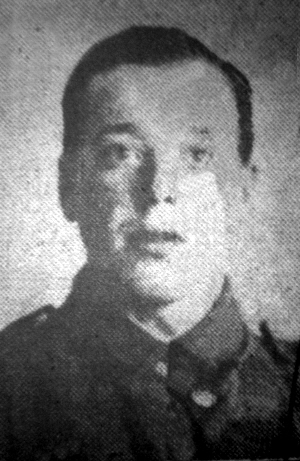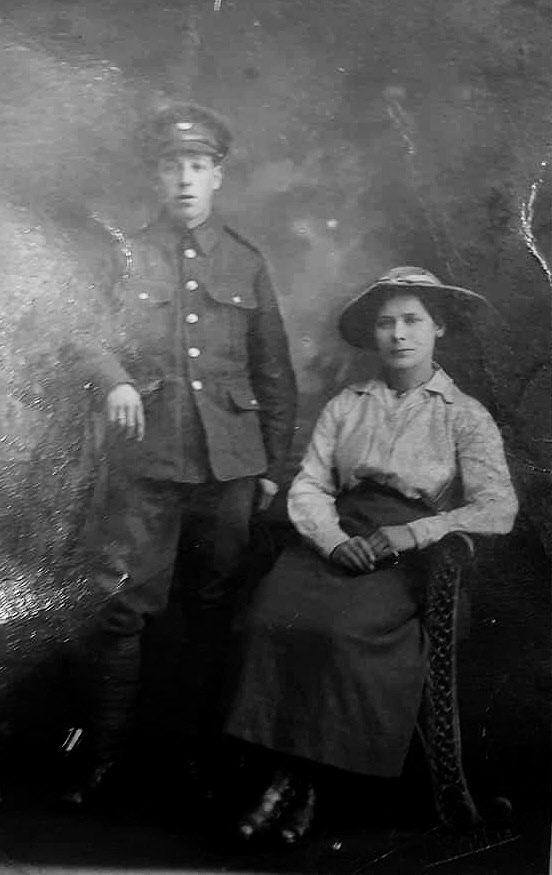 Private George Smith, 200303, King's Own Yorkshire Light Infantry, 1st/4th Battalion
Private George Smith, 200303, King's Own Yorkshire Light Infantry, 1st/4th Battalion
George Smith was born in Staincross, Barnsley in 1893, the eldest child of four surviving children born to coal miner John Smith and his wife Florence (nee Summerscales) who married in 1892. In the mid 1890s the family moved to Ossett and in 1901 John Smith, wife Florence and two of their children, including George were living on Buck Trap Lane (now Roundwood Road), off Teal Street, Ossett.
In 1911 John Smith, Florence and their four children, three sons and a daughter, were living at 62, Veto Buildings, Manor Road Ossett. Like his father, George was a coal miner and both were probably working at nearby Old Roundwood Collieries.
George Smith’s army service record has not survived, but it is known that Staincross-born George enlisted at Ossett and joined the 1st/4th Battalion of the King’s Own Yorkshire Light Infantry with service number 200303. He also had an earlier four digit service number 2083, suggesting that he had previously served in KOYLI in the Territorials. Private George Smith embarked for France on the 13th April 1915. He died of pneumonia on the 5th May 1918 and was posthumously awarded the British and Victory medals and also the 1914/15 Star.
The 1/4th Battalion, Kings Own Yorkshire Light Infantry was a unit of the Territorial Force with HQ in Wakefield, serving with 3rd West Riding Brigade, West Riding Division. When war broke out in August 1914, the units of the Division had just departed for their annual summer camp at Whitby, and they were at once recalled to their home base and mobilised immediately for war service, moving to Doncaster. In November they moved to Gainsborough and in February 1915 to York to prepare for service overseas, those men who had not volunteered for Imperial Service transferred to the newly formed 2/4th Battalion. They proceeded to France, from Folkestone landing at Boulogne on the 12th of April 1915 and the Division concentrated in the area around Estaires. On the 15th of May the formation was renamed 148th Brigade, 49th (West Riding) Division. Their first action was in the The Battle of Aubers Ridge in May 1915. In 1916 They were in action in the Battles of the Somme. In 1917 they were involved in the Operations on the Flanders Coast and the The Battle of Poelcapelle during the Third Battle of Ypres. In 1918 they were in action during the Battles of the Lys, The pursuit to the Selle and the Final Advance in Picardy. At the Armistice, The 49th Division was resting at Douai, demobilisation began in early 1919.
The "Ossett Observer" 1 had this short obituary for George Smith:
"South Ossett Man's Death In Hospital - Mr. and Mrs. J. Smith, of Veto-buildings, Ossett Common, have been informed that their son, Private George Smith (25), King's Own Yorkshire Light Infantry, has died in hospital at Boulogne from pneumonia. Private Smith was one of the Territorials who were in camp at Whitby when war broke out and were mobilised forthwith, though a good many months elapsed before they went into the fighting area, they have had many rough experiences with the enemy, and Private Smith has been through his share. Before the war he worked at Crigglestone colliery."
Shortly after Private Smith's death, his mother received this letter from Captain Archibald Malbeck, Canadian Army Medical Corps who worked in the Canadian Army field hospital in Boulogne:
"3rd Canadian General Hospital, B.E.F.
31st May 1918
Dear Mrs. Smith - We have received a letter here (from Mrs. (Miss!) E. Proctor) who wrote for you making enquiries about your son who died here on the 5th of May. Your son was taken ill with pneumonia on the 25th April and was admitted to this hospital the following day. By that time he was quite delirious. He was extremely ill even at the first and although we tried to do all we could for the poor fellow, he died on the 5th of May. He received the greatest care possible from the sisters on the ward, but we soon saw that the infection was so severe that he had no chance of recovery. You have asked if he was conscious before he died. No, he was quite unconscious. I am sure that he suffered no pain. The sister asked your son George if he wished her to write to you, but apparently he was unable to comprehend the question.
It is so sad to see such a fine young fellow snatched away and we all took a great liking to him. I hope, Mrs. Smith, that your own health has improved. Please accept my sympathy in your sad loss.
Yours faithfully - Archibald Malbeck (Capt. C.A.M.C.)"

Above: Picture showing Private George Smith and his girlfriend courtesy of Private Smith's great-niece Andrea Westbury, who also kindly allowed us to transcribe the letter reproduced above from the 3rd Canadian General Hospital in Boulogne where Private Smith died.
Private George Smith, aged 25 years, son of John and Florence Smith, of 62, Veto Buildings, Manor Road, Ossett, died on the 5th May 1918. He is buried at grave reference IX. B. 48 at the Boulogne Eastern Cemetery,2 Pas de Calais, France. Boulogne-sur-Mer is a large Channel port. Boulogne Eastern Cemetery, one of the town cemeteries, lies in the district of St Martin Boulogne, just beyond the eastern (Chateau) corner of the Citadel (Haute-Ville).
The cemetery is a large civil cemetery, split in two by the Rue de Dringhen, just south of the main road (RN42) to St Omer. The Commonwealth War Graves plot is located down the western edge of the southern section of the cemetery, with an entrance in the Rue de Dringhen. Unusually, the headstones are laid flat in this cemetery. This is due to the sandy soil. Car parking is available along the Rue de Dringhen.
Boulogne, was one of the three base ports most extensively used by the Commonwealth armies on the Western Front throughout the First World War. It was closed and cleared on the 27 August 1914 when the Allies were forced to fall back ahead of the German advance, but was opened again in October and from that month to the end of the war, Boulogne and Wimereux formed one of the chief hospital areas.
Until June 1918, the dead from the hospitals at Boulogne itself were buried in the Cimetiere de L'Est, one of the town cemeteries, the Commonwealth graves forming a long, narrow strip along the right hand edge of the cemetery. In the spring of 1918, it was found that space was running short in the Eastern Cemetery in spite of repeated extensions to the south, and the site of the new cemetery at Terlincthun was chosen.
Boulogne Eastern Cemetery contains 5,577 Commonwealth burials of the First World War and 224 from the Second World War.
References:
1. "Ossett Observer", 11th May 1918